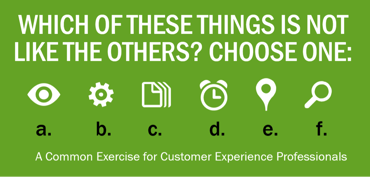In an industry that’s growing as quickly and expanding in as many directions as customer experience (CX) is, it’s not at all surprising to see a significant amount of confusion when it comes to a 'taxonomy' of CX.
Over the last three years, we’ve seen dozens of companies across industries re-brand themselves with one flavor or another of customer experience programs. Ranging from software behemoths selling CRM, call center, and customer service solutions to myriad design firms, branding agencies, and IT consulting firms, customer experience is proving to be a pretty big tent indeed.

The Multiple Definitions of a Customer Experience Program
A quick search for 'Customer Experience Program' shows that it means different things to different vendors:
- An approach to effect complete transformation to a customer-centric organization
- The way to design a Voice-of-the-Customer listening program
- Voice-of-the-Customer software
- Customer service representative training
- Customer service management software
- A way to determine the emotional drivers of experience
- And more…
You get the idea–and as a result, for those organizations trying to improve or manage their customers' experience, this mix of solutions, programs, services, and software can be a tangled ball.
Point solutions can help close gaps in the customer experience, but are incapable of helping organizations actually differentiate–which is the stated end goal of customer experience efforts for more than half of CX professionals. Or, the wrong solution can push them down a path to cultural transformation when all they really want is to close service gaps.
Focus First on Customer Experience Improvement Objectives, Then Define Potential Solutions.
To ensure their efforts are on the right track, I’d suggest that those interested in customer experience improvement focus on objectives rather than solutions. This sounds über simplistic, and perhaps it is. But if you’d seen as many investments in CX fail to deliver desired results as I have, it’s clear that simplicity is a very good thing.
With this in mind, the first step for any company is a clear understanding of its business objectives. Some of the most common things companies want to do when building their customer experience program–and some of the solutions and tools that support them–include:
-
Differentiate (and/or Innovate) on Customer Experience:
Let’s be clear; this isn’t a simple path. To start down it, you’ll almost certainly need outside help (see 'customer experience consultants') to help define CX strategies that are aligned to your business and brand strategies, as well as to develop the capabilities to consistently design and deliver differentiated, innovative customer experiences. -
Understand Your Customer Experience:
This means lots of different things, but some of the most common 'getting started' tools include customer journey maps, which help to gather and present both internal and customer perspectives of the current journey. Software tools (see next bullet) are also great at helping to understand your customers and how they feel. -
Listen to Your Customers:
For most companies, this means engaging an outside vendor to design and/or deploy a Voice-of-the-Customer (VoC) program. The program is your approach to gathering, analyzing, taking action on, and monitoring customer insights. The tools that help you do so are VoC software solutions. In the context of CX, this also entails discrete customer research programs and analysis of the loyalty drivers across your customers’ experience. -
Become More Customer-Centric:
This means different things as well. And while software can help support this shift, from a goals perspective it’s primarily defined as either a cultural shift towards customer-centricity (and the training and realignment that implies), and/or the enablement of a customer experience management capability, which helps operationalize the ways that a company manages the overall customer relationship. -
Deliver Better Customer Experiences:
I debated adding this, because while the goal of delivering better customer experiences is a clear one, the way you get there is usually through some combination or subset of the objectives above. This said, there are two end points to the 'better customer experience' continuum, so be clear which one you’re on. On one end, this means identifying, prioritizing, and closing existing gaps. On the other end of the spectrum is the design and delivery of experiences that meet unmeet customer needs–CX innovation.
By no means exhaustive, these high-level goals represent more than half of the enquiries we receive, and the kinds of work our firm does to help organizations. Ranging from quick-win sprints to longer-term strategic goals, the scope of the solution is directly related to the scale of the issue at hand, and an organization's willingness to address it.
Other objectives we hear include everything from boosting customer loyalty and employee engagement to customer experience training and digital innovation. No matter what you’re trying to accomplish, the ability to meet your goals is directly correlated with your ability to define them. And of course, just because it sounds simple doesn’t mean it is...

